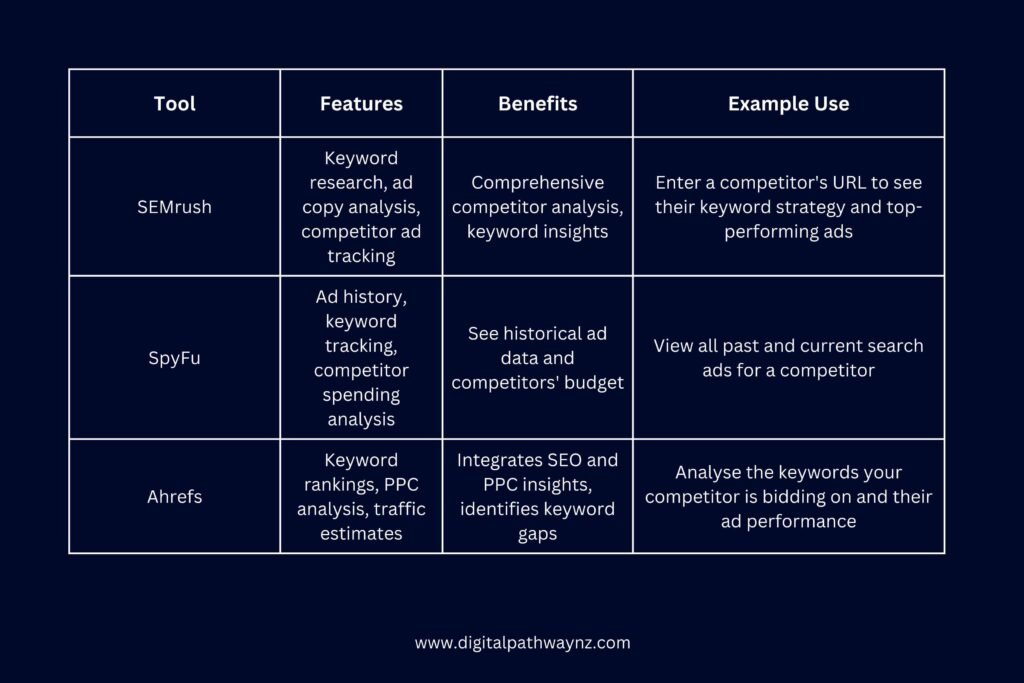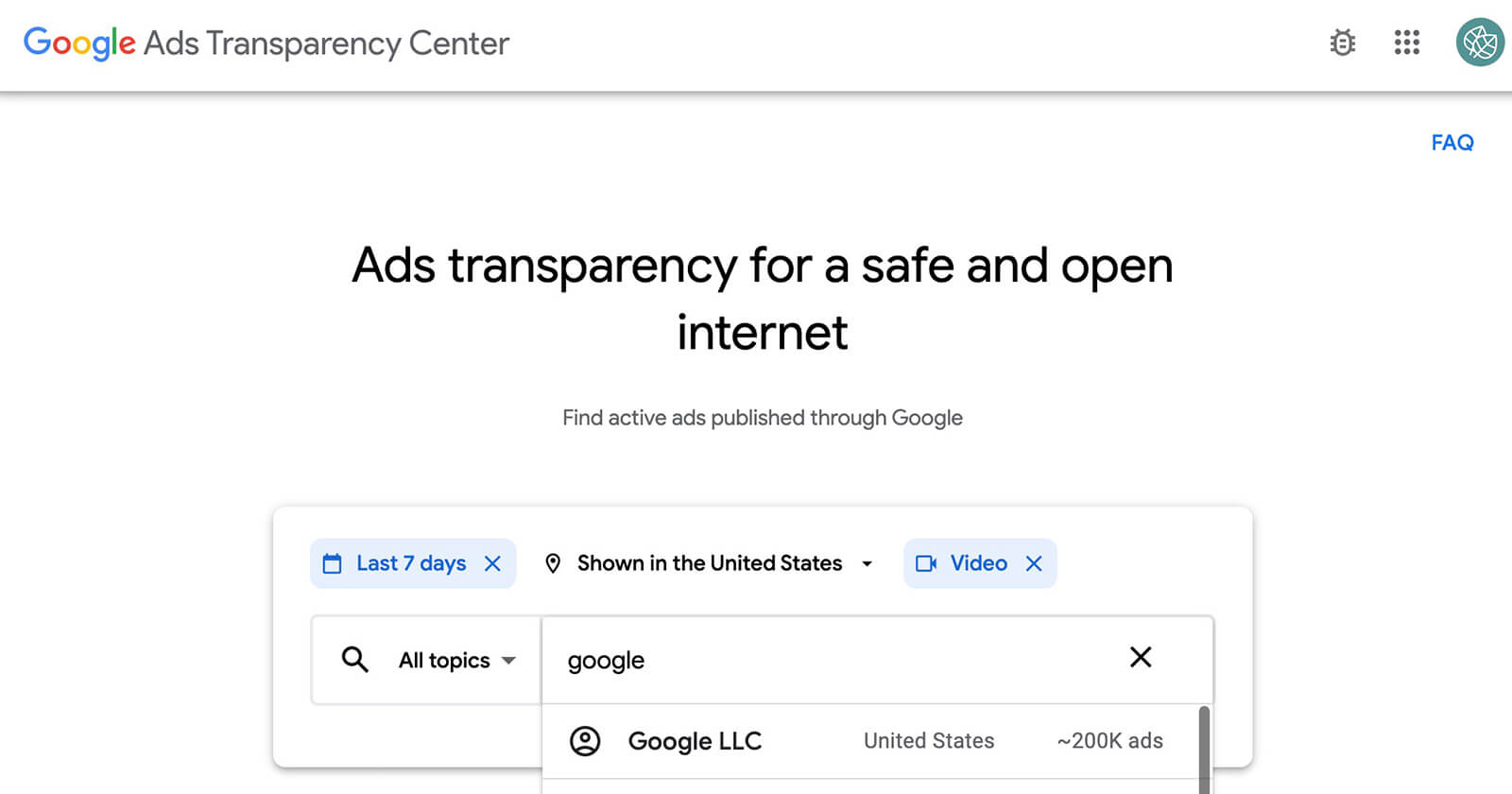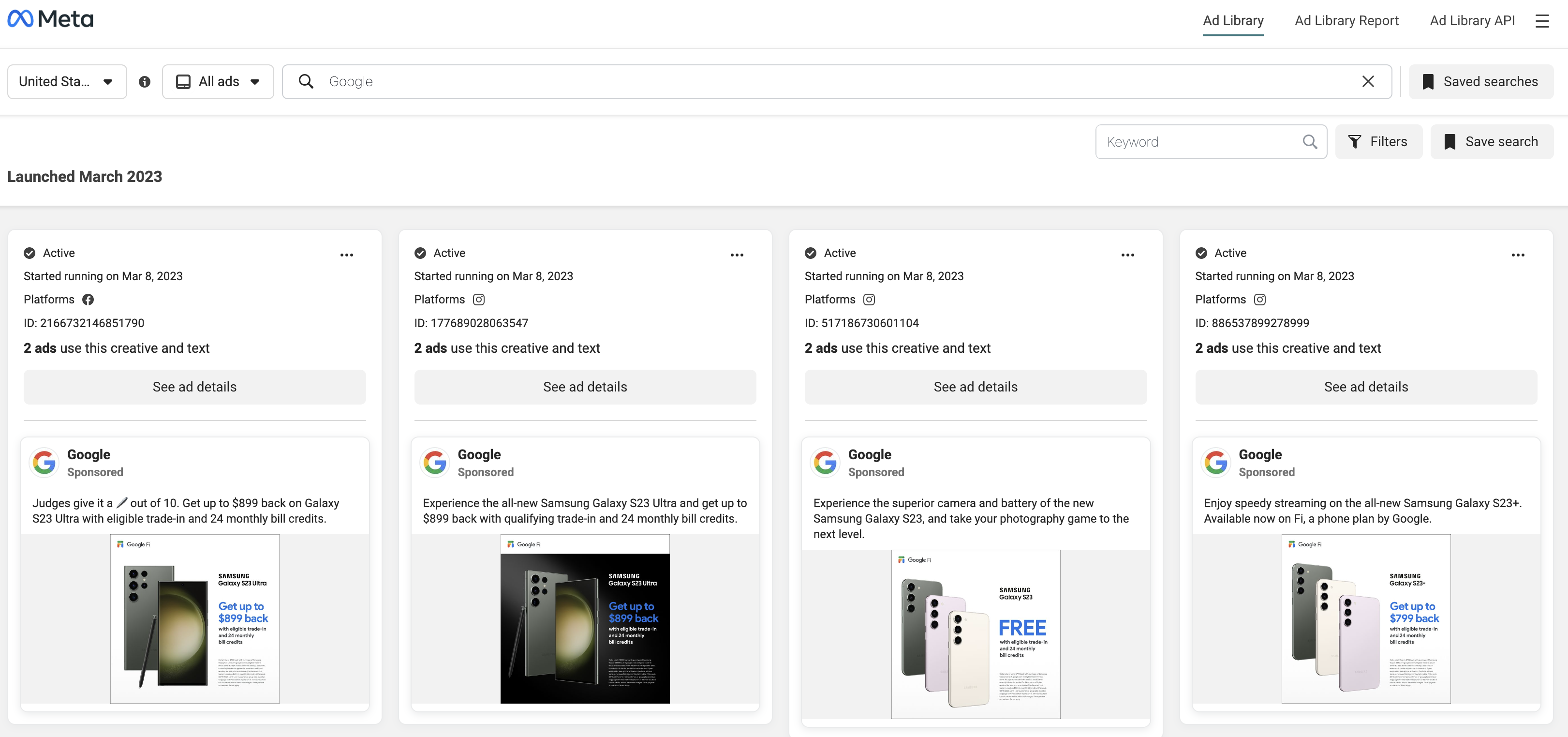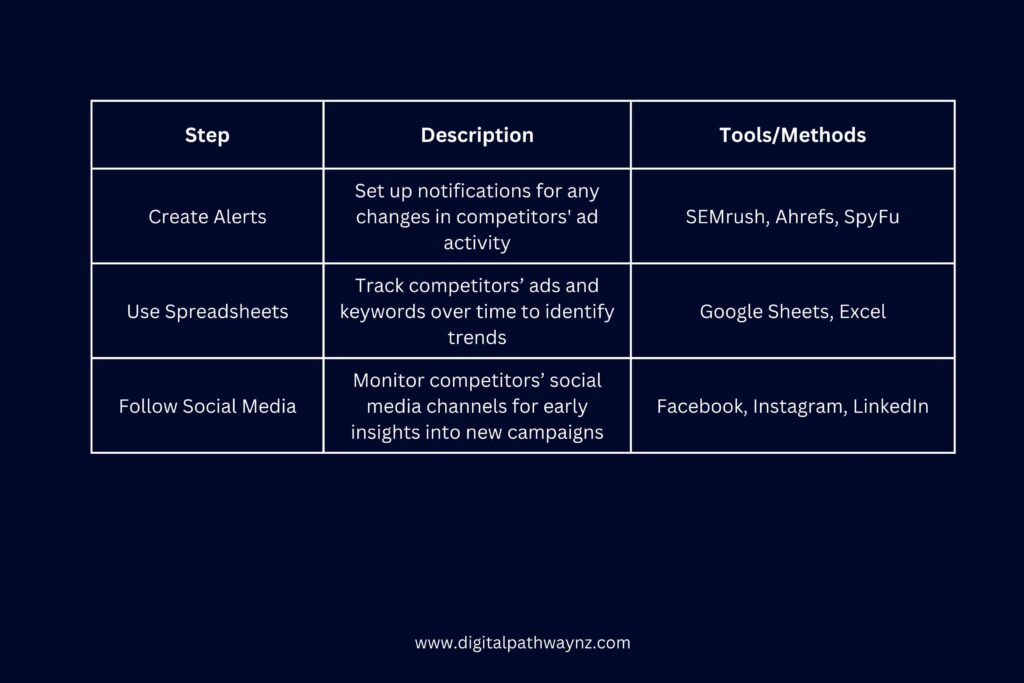In the competitive world of digital marketing, keeping an eye on what your competitors are doing is crucial. Understanding their search ad strategies can provide insights into their tactics, allowing you to adjust your approach, identify gaps, and capitalise on opportunities. This step-by-step guide will walk you through how to find and analyse your competitors’ search ads, using tools and techniques that will enhance your marketing strategy.
Step 1: Identify Your Competitors

Before you can analyse competitors’ search ads, you need to identify who your competitors are. This might sound straightforward, but it’s important to consider both direct and indirect competitors.
- Direct Competitors: These are businesses offering the same products or services as you, targeting the same audience.
- Indirect Competitors: These companies might not offer the exact same product or service, but they satisfy the same customer need or solve a similar problem.
Example: If you’re a New Zealand-based sustainable fashion brand, your direct competitors could be other sustainable clothing brands within New Zealand, like Kowtow or Marle. Indirect competitors might include larger fashion retailers like H&M or Zara, which have sustainable product lines.
How to Identify Competitors:
- Google Search: Perform searches using the keywords you are targeting. The companies that appear in the search results are likely your competitors.
- Customer Feedback: Ask your customers who else they considered before choosing your brand.
- Industry Reports: Use industry-specific reports and market analyses to identify key players in your niche.
Step 2: Use Google’s Search Results
The simplest way to find competitors’ search ads is by performing Google searches using the keywords relevant to your industry.

How to Do It:
- Open Google in an Incognito Window: This helps avoid personalised search results that could skew the data.
- Search for Keywords: Type in keywords that are central to your business. Look for the ads that appear at the top and bottom of the search results.
- Analyse the Ads: Take note of the headlines, descriptions, call-to-actions, and any ad extensions like sitelinks or callouts.
Example: If you search for “sustainable knitwear in NZ,” and see an ad from a competitor with a headline like “Ethically Made Wool Jerseys – Free Shipping NZ Wide,” you can take note of the specific offers and wording they are using.
Step 3: Use Google Ads Transparency Features & Meta Ads Library
Google has made it easier to see the ads running for any business through its Ads Transparency Center.


How to Do It:
- Visit Google’s Ads Transparency Center and Meta Ads Library: You can access this through the “About this ad” option when you see an ad in Google search results.
- Search for Your Competitor’s Name: This will show you all the ads they are currently running, not just those triggered by specific keywords.
- Review Ad Copies and Strategies: This gives you a broader view of their ad strategy, including the variety of ads and messages they are testing.
- How to Find Your Competitor’s Ads: A Comprehensive Guide
Example: By entering a competitor’s brand name, like “Kowtow,” into the Ads Transparency Center, you can see all the current search ads they are running. This might reveal if they are focusing on a new collection or pushing a sale.
Step 4: Use Third-Party Tools
Several tools are specifically designed to help you analyse competitors’ search ads. These tools often provide more in-depth insights than what you can gather manually.
Recommended Tools:
- SEMrush: This tool offers a comprehensive view of your competitor’s search ads, including the keywords they are bidding on, their ad copy, and estimated traffic.
- SpyFu: SpyFu allows you to see the keywords your competitors are buying on Google and the ads they have run in the past.
- Ahrefs: While primarily an SEO tool, Ahrefs also provides insights into PPC strategies, including competitor ads.
How to Use These Tools:
- Enter Your Competitor’s URL: Start by entering the URL of a competitor’s website into the search bar of the tool you’re using.
- Review Ad Copy and Keywords: Look at the list of ads and keywords they are bidding on. Most tools will show you the estimated budget they are spending, which ads are performing well, and how their strategy has evolved over time.
- Export Data for Analysis: Many tools allow you to export this data into a spreadsheet, making it easier to analyse trends and patterns over time.
Example: Using SEMrush, you could enter “we-ar.com” and discover that they are bidding on keywords like “ethical yoga clothing” and “eco-friendly fashion.” You can also see which of their ads are driving the most traffic.
Step 5: Monitor Competitors’ Ads Regularly
The digital marketing landscape changes quickly, and so do competitors’ strategies. Regular monitoring ensures that you stay informed and can react to changes in the market.

How to Set Up Monitoring:
- Create Alerts: Tools like SEMrush and Ahrefs allow you to set up alerts for changes in your competitors’ ad activity. This can include new keywords they start bidding on or new ads they launch.
- Use Spreadsheets: Keep a spreadsheet where you regularly log competitor ads, keywords, and any changes you notice. Over time, this will help you identify trends.
- Follow Competitors on Social Media: Competitors may announce promotions or product launches on social media before they appear in search ads. Staying connected with their social media channels can give you early insights.
Example: By setting up an alert in SpyFu for a competitor like H&M, you might get notified when they start a new ad campaign focused on sustainable fashion, allowing you to quickly adjust your strategy.
Step 6: Analyse and Adapt Your Strategy
Once you’ve gathered data on your competitors’ search ads, the next step is to analyse the information and adapt your strategy accordingly.

Areas to Focus On:
- Ad Copy: How does your ad copy compare to your competitors’? Look at the language, tone, and offers they use. Can you refine your messaging to be more compelling?
- Keyword Strategy: Are there high-performing keywords that you’re not bidding on? Conversely, are there keywords that are too competitive to be worth pursuing?
- Budget Allocation: How does your budget compare to your competitors’? If they’re dominating a certain keyword, consider whether it’s worth increasing your bid or focusing on a niche keyword instead.
Example: If your competitor is using ad copy that heavily focuses on “free shipping,” and you’ve noticed that’s resonating with customers, you might consider emphasising your own shipping options more in your ads.
Step 7: Test and Iterate
Digital marketing is all about testing and optimisation. Once you’ve adapted your strategy based on your competitor analysis, it’s important to continually test and refine your approach.

Testing Methods:
- A/B Testing: Run A/B tests on your ad copy, landing pages, and keyword bids to see what resonates best with your audience.
- Performance Tracking: Use Google Ads reports and third-party tools to track the performance of your ads. Compare metrics like click-through rates (CTR), conversion rates, and cost-per-click (CPC) against your competitors.
- Iterative Improvements: Based on your test results, make iterative improvements to your ads. This could involve tweaking headlines, adjusting bids, or experimenting with new keyword combinations.
Example: If you find that ads focusing on “NZ-made” products are performing well for your competitors, test including this in your own ad copy to see if it boosts your performance.
Conclusion
Finding and analysing your competitors’ search ads is an essential part of staying competitive in the digital marketing landscape. By following these steps—identifying competitors, using Google’s search results and transparency tools, leveraging third-party tools, regularly monitoring ads, analysing the data, and continually testing—you can gain valuable insights into your competitors’ strategies and refine your own approach.
By understanding what works for your competitors, you can stay ahead of industry trends, adapt quickly to market changes, and ultimately drive better results for your business. Remember, the goal isn’t just to copy what your competitors are doing, but to learn from their strategies and apply those insights to your unique brand and audience. With diligent research and strategic adaptation, you can turn competitor insights into a powerful tool for growth in your search ad campaigns.
- A Step-by-Step Guide to Finding Competitors’ Search Ads
- The 4 Ps of Marketing: What They Are & How to Use Them Successfully in New Zealand
- A Comprehensive Guide to PPC Marketing in New Zealand
- How New Zealand Hospitality Brands Use Digital Marketing to Drive Foot Traffic
- Must-Listen Podcasts for Digital Marketing Professionals in NZ
